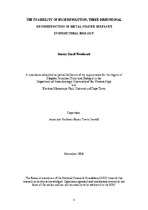| dc.description.abstract | Life is an emergent property of a complex network of interacting cellular-machines. Three-dimensional (3D), cellular structure captured at supra-atomic resolution has the potential to revolutionise our understanding of the interactions, dynamics and structure of these machines: proteins, organelles and other cellular constituents, in their normal functional states. Techniques, capable of acquiring 3D cellular structure at sufficient resolution to enable identification and interpretation of individual macromolecules in the cellular milieu, have the potential to provide this data. Advances in cryo-preservation, preparation and metal-coating techniques allow images of the surfaces of in situ macromolecules to be obtained in a life-like state by field emission scanning – and transmission electron microscopy (FE/SEM, FE/TEM) at a resolution of 2-4 nm. A large body of macromolecular structural information has been obtained using these techniques, but while the images produced provide a qualitative impression of three-dimensionality, computational methods are required to extract quantitative 3D structure. In order to test the feasibility of applying various photogrammetric and tomographic algorithms to micrographs of well-preserved metal-coated biological surfaces, several algorithms were attempted on a variety of FE/SEM and TEM micrographs. A stereoscopic algorithm was implemented and applied to FESEM stereo images of the nuclear pore basket, resulting in a high quality digital elevation map. A SEM rotation series of an object of complicated topology (ant) was reconstructed volumetrically by silhouette-intersection. Finally, the iterative helical real-space reconstruction technique as applied to cryo-TEM micrographs of unidirectionally heavy-metal shadowed. These preliminary results confirm that 3D information obtained from multiple TEM or SEM surface images could be applied to the problem of 3D macromolecular imaging in the cellular context. However, each of the various methods described here comes with peculiar topological, resolution and geometrical limitations, some of which are inherent shortcomings of the methodologies described; others might be overcome with improved algorithms. Combined with carefully designed surface experiments, some of the methods investigated here could provide novel insights and extend current surface-imaging studies. Docking of atomic resolution structures into low-resolution maps derived from surface imaging experiments is a particularly exciting prospect. | en_US |

